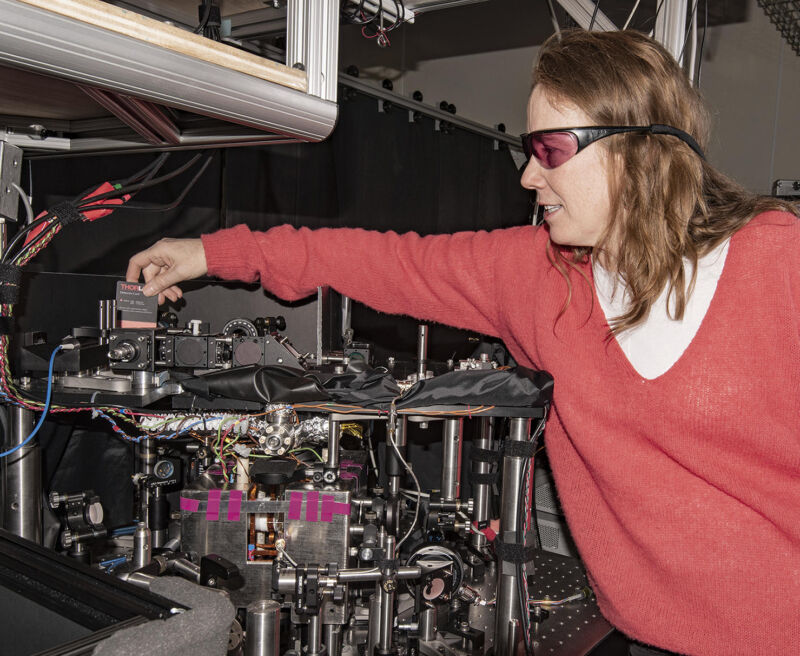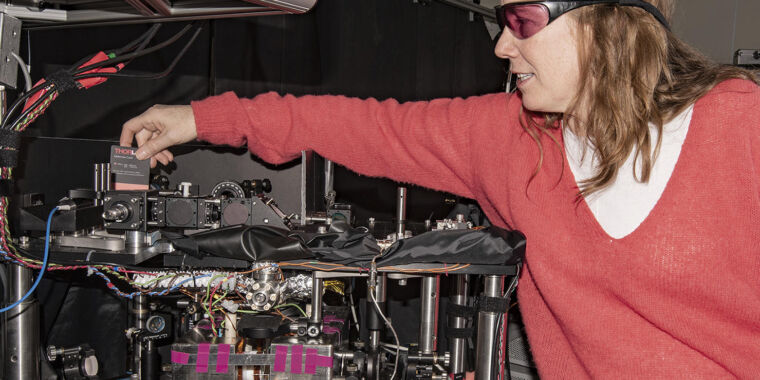
A team of researchers from France has developed the first three-directional hybrid quantum inertial sensor, which can measure acceleration without using satellite signals. At the heart of this breakthrough device is something called “matter wave interferometry,” which uses two distinct characteristics of quantum mechanics: wave-particle duality and superposition.
In the cloud
The device consists of a cloud of rubidium atoms that are cooled to temperatures nearing absolute zero. The atoms are placed in a vacuum and are in free fall due to gravity.
Once cooled, a series of three laser flashes are shone on the atoms, creating matter waves in the rubidium atoms. According to the laws of quantum mechanics, at extremely low temperatures, atoms do not behave like standard particles. They also behave as waves that can undergo diffraction and interference like light does.
After the laser beam strikes the atoms, they first experience changes in their energy states.
“As per quantum mechanics, you can describe the atom [as] being both in a ground state and an excited state simultaneously. In other words, the atom has absorbed some light and has not absorbed any light at the same time. This strange state is called quantum superposition,” said Philippe Bouyer, professor at Institut d’Optique and coordinator of the Quantum Delta NL quantum sensing program.
A rubidium atom in this state can thus be described as two matter waves going in different directions. “One is the state where the atom follows its trajectory as if it never interacted with the light while the other wave follows a trajectory as if it was pushed by the light,” Bouyer, who is a co-author of the paper, said.
A second laser pulse, sent in quick succession, inverts the two states, while a third pulse ensures that the paths overlap, enabling the interference. This process is repeated three times successively, with the laser beam aligned each time on a different orientation axis.
As the device changes its momentum, there is a shift in the interference fringes. This is measured against a reference, in this case, a retro-reflecting mirror that reflects the laser beam from the laser source onto the rubidium atoms.
“The mirror, one on each axis, tells you where the laser is. Since the atoms are constantly falling down due to gravity, what we measure is the relative acceleration between the mirrors and the atoms,” Bouyer said.
High precision
The quantum inertial sensor doesn’t require any calibration, as the energy levels of the atoms, the frequency of the light, and the photon momentum to which it corresponds are known beforehand. Along with the time taken for the interference to occur and the frequency of the laser, acceleration can be calculated by using equations of mechanics.
Moreover, at temperatures close to absolute zero, the motion of the atoms can be controlled to a precision of one centimeter per second instead of 500 meters per second at room temperature, which enables the detection of small changes in velocity.
However, the sensor has one drawback: It cannot take continuous measurements. “You need time to make very good measurements. For example, while measuring an interference fringe that may take 100 milliseconds—if there are velocity changes during this time, there is no way to know about it,” he said.
Bouyer and his team found a way around this problem by integrating the quantum sensors with classical accelerometers. “We use the quantum measurement to correct in situ the non-perfect measurement of the classical accelerometer. The output is this corrected signal,” said co-author Baptiste Battelier.
Battelier added that the new sensor emits a steady signal with 50 times greater precision than classical accelerometers. This is the reason that the hybrid sensor doesn’t require bias correction through external signals provided by satellites. Don’t expect these things to show up in your phone any time soon, though. All the hardware requires about a cubic meter of space, and the researchers estimate that costs will run in the range of several hundred thousand dollars.
“The biggest advantage of such a sensor, which can be used in submarines, airplanes, and boats, is privacy and autonomy,” Battelier said.
Dhananjay Khadilkar is a journalist based in Paris.








